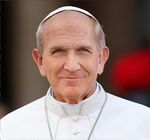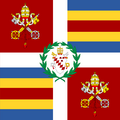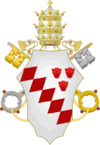Fabria
Sacred Fabia Fabria Sacra | |
|---|---|
| Location of the Sacred Fabria within Castellum Location of the Sacred Fabria within Castellum | |
| Country | |
| Fief granted | 19 April 1679 |
| Official languages | Latin |
| Religion | Fabrian Catholicism |
| Government | Ecclesiastical elective fief within a semi-constitutional monarchy |
• Emperor | Constantine XX Claudius |
• Pope | Pontian XI |
• Prefect | Constantinus Apronianus |
| Theodorus Afinius | |
| Legislature | Pontifical College |
| Population | |
• 2021 estimate | 800 |
| Currency | Solidus ($) |
| Time zone | +4 (IT) |
| Date format | dd/mm/yyyy (AD) |
| Driving side | left |
| Calling code | +4 099 |
| ISO 3166 code | IL FS |
| Police | Alba Pontificalis Vigiles |
| Patron saint | Saint Peter |
Fabria, officially Sacred Fabria (Latin: Fabria Sacra), is a Papal fief and special administrative located entirely within Castellum ab Alba. Unlike the independent Pontifical State that preceded it, Fabria is a special administrative area subject to Latium and its laws, located entirely within the city of Castellum ab Alba. Fabria is governed through the 1679 Treaty on Liberties and Privileges, which, along with restoring the Papacy to its original seat in Fabria, Castellum, established the relationship between the Emperor and the Pope.
Fabria dates back to early Sarpetism and early Christianity as the primary episcopal see of the Fabrian Church led by the Bishop of Alba, with the support of the ancient Latin emperors. The Papacy fled Castellum during the Ostian War and the Crisis of the Eleventh Century, later establishing its seat in Sicaea, located in parts of modern day Lihnidos. The modern tenancy of the papacy in Castellum began during the Wars of Religion and the eventual Sack of Sicaea, which resulted in the near destruction of papal authority. The 1679 Treaty on Liberties and Privileges resulted in the restoration of the Papacy to its original seat in Castellum, in the Fabria district.
Its government structure is governed by the 1679 Treaty that established it as an ecclesiastical fief held by the Pope to provide him with a seat for Papal Court, administrative, diplomatic, spiritual and offices, as well as use of Archbasilica of Saint Peter and other facilities within the territory. However, the territory of Fabria does not confer any sovereignty, which is instead placed upon the office of Papacy by longstanding international law. As a result, various national governments hold embassies with the Pope, most of which are located within Fabria.
Today, Fabria is home to approximately 500 residents. It is home to a number of cultural and religious sites, such as the Archbasilica of St. Peter, Fabrian Museums, Fabrian Archives, and the Great Chapel. The local economy is primarily supported through financial donations, the sale of souvenirs, admission fees at museums or galleries, and financial support from the Latin emperors.
History
Early papal seat
Sack of Sicaea
Papal fief
Geography
Boundary
Governance
Fabria is governed as a special administrative division in Latium, located entirely within Castellum ab Alba. At its core, Fabria is governed as an ecclesiastical elective fief within a semi-constitutional monarchy, held by the Pope. The Pope is granted wide-reaching executive, legislative, and judicial authority in Fabria by the 1679 Treaty on Liberties and Privileges, though in most instances Papal temporal prerogative is limited by the Emperor. Fabria is a distinct entity from the Holy See, the latter of which is a sovereign entity for the purposes of international law.

|
| Pontian XI Pope |
The pope is the chief executive within Fabria, with legislative authority invested in the Pontifical College. The Pontifical College is a body of 15 cardinals or senior church leaders appointed by the Pope for a term of years, upon the consent of the Emperor. The President of the College is the presiding officer of the Pontifical College. The Prefect is the head of government of Fabria, appointed by the Pope upon the consent of the Emperor; he is charged with governance of Fabria at the pope's direction. As with many government offices in Fabria, officeholders often simultaneously hold the same role within the Holy See. Additional offices exist for health, security, and communications.
The Pontifical Court is closely associated with Fabria and its administration. The prestigious historical court offices of Master of Horse, Master of Offices still perform functional duties for the Holy See and Fabria. The Camerlengo presides over the Papal Treasury, is held by a cardinal, and is entrusted with administration and protection of papal properties and rights. Often the role will serve as an intermediary with Latin officals on matters relating to governance of Fabria.
Fabria also features a limited judiciary with both a civilian court and ecclesiastical court. The civilian court is division of the Judicial District of Castellum. Misdemeanor criminal matters are handled by the Fabrian Division of the Velia Inferior Criminal Court, and felonies by the Fabrian Division of the Alba Criminal Tribunal. The 1679 Treaty does not provide for private matters, and per 1955 agreement between Diana I Anicia and Pope Pontian X, all private or civil matters that originate within Fabria fall within the jurisdiction of Velia Inferior Court and Alba Tribunal. Additionally, the pope appoints, upon the emperor's assent, no more than 5 ecclesiastical judges for criminal matters that arise within Fabria involving members of the clergy or other Pontifical officers.
Defense and law enforcement
Military defense is provided to Fabria and the pope by the Latin legions, with internal security provided by a special division of the Alba Vigiles known as the Pontificalis Vigiles. The Pontificalis Vigiles is a separate entity from the Papal Guard, and ensures public order at the audiences, meetings and ceremonies within Fabria, security, public order, border control, traffic control, criminal investigation, and other general police duties within Fabria. Its commander is appointed by the emperor.
Conversely the Papal Guard provides protection to the pope, the college of cardinals, and security of their persons and buildings and travel with the Pope abroad. The Legate of the Papal Guard is appointed by the pope upon the emperor's assent.
Foreign relations
Fabria is defined as a special administrative district of Latium, and as such lacks any sovereignty on its own. However, the Holy See is considered sovereign by longstanding international law, allowing the Holy See to conduct diplomatic relations on the pope's behalf. This also enables the pope to engage in international agreements. Due to the limited amount of territory granted to the Pope in the Fabrian fief, few embassies, if any, are located within the fief, and are instead located in Castellum. Typically, embassies accredited to Latium are also accredited to the Holy See or house a separate envoy to the Holy See.
Economy
Fabria is primarily supported by tourism, admissions to museums, and support from the Imperial treasury. Other industries include printing, and management of the Holy See's international assets and properties. The Cardinal Secretary for Largesses is responsible for economic activity in Fabria, and all financial and administrative activities of the Holy See. The current Cardinal Secretary for Largesses is Cardinal Aurelius Hispallus.
Demographics
The most recent Imperial census placed the population of Fabria at 807 individuals, of which 356 were members of the clergy, and 107 were members of the Papal Guard. As such, the primarily population of Fabria is composed of clergy members, lay employees of the fief government.
Language
Latin is the sole official language of Fabria, and it is the only language used in official documents, legislation, and official communications.
Infrastructure
Fabria has a highly developed level of infrastructure due in part to being located entirely within Castellum, and its limited size that consists mainly of plazas and walkways. It contains no airports of its own, but the nearest international airport is located 15 miles north. Fabria contains a single heliport. Fabria is serviced by stops on the Latin National Railway and Alban Metro. Both stops within Fabria are serviced by their respective Latin systems.

